Just over two months after John Egan’s stoppage-time winner at the Bramall Lane that gave Sheffield United a narrow 1-0 win over Wolverhampton Wanderers, the stadium was ready to welcome the Wolves yet again to kick off the new 2020/21 Premier League season for both the teams.
Both the teams came into the game with a contrasting nature of pre-season behind them. While Wilder’s men played four games during the pre-season, a stretched 2019/20 campaign for the away side meant that they were forced to start the new season without any pre-season games under their legs. Hence, it was only natural that Nuno Espírito Santo’s men lacked the match fitness compared to their opponents which gave the Blades a slight advantage on paper. However, matches are not won on paper and the Wolves showed exactly that by winning the game 2-0. The away side showcased a professional performance by scoring two early goals in the first half and then holding the lead with resolute defending in the second half, thus taking away all the three points from the Bramall Lane for the first time in over six years.
In this tactical analysis, we will analyze the tactics that were employed by both the managers. We will also do an analysis of the issues of the hosts that lead to their defeat along with the tactics that Nuno got right that earned his team a hard-fought victory.
Lineups
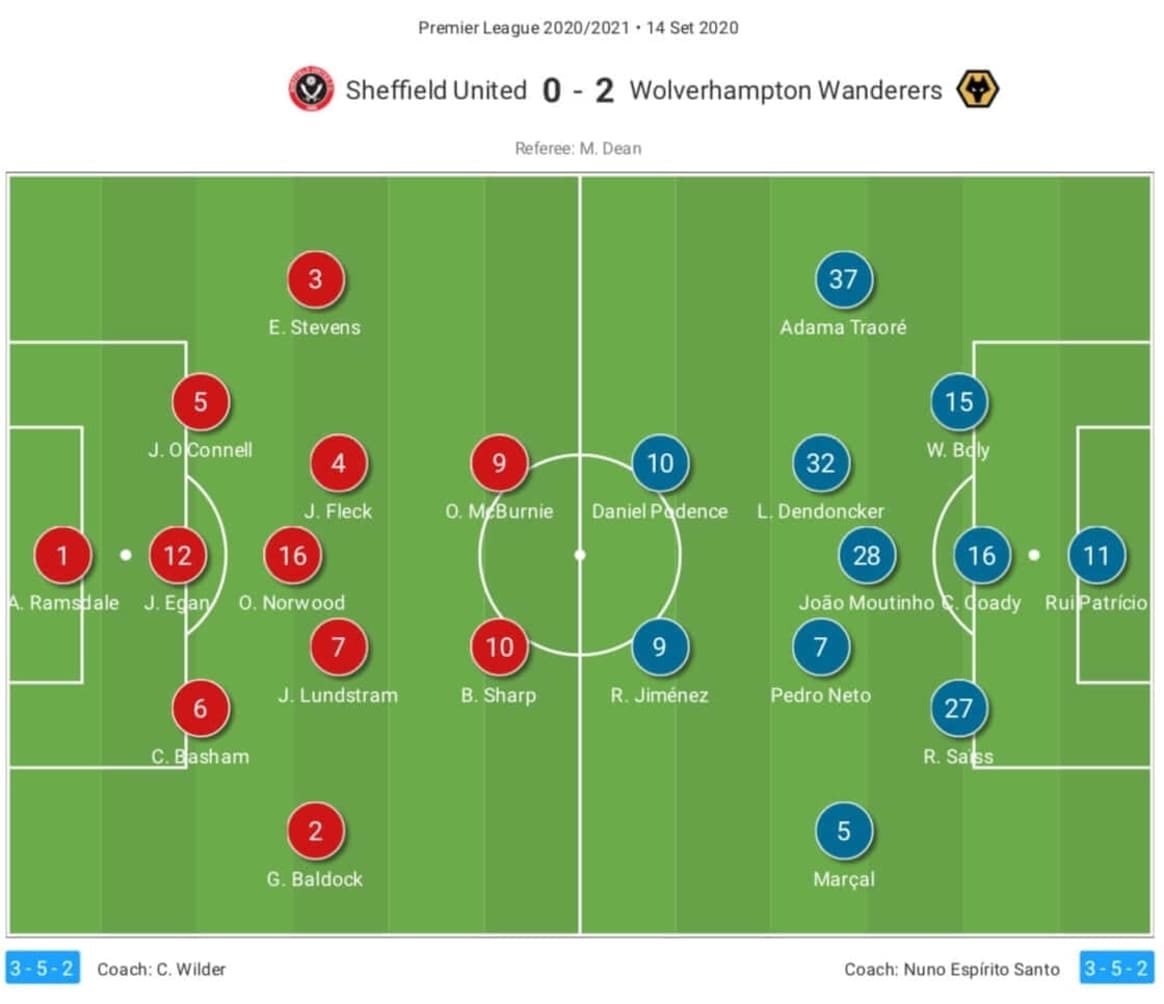
Chris Wilder did not surprise many with his usual 3-5-2 system. Aaron Ramsdale, the new £18.5 million signing from Bournemouth, started between the sticks after Dean Henderson’s return to his parent club Manchester United. Wilder went with his favorite and trusted back five of Chris Basham, Egan, and Jack O’Connell at the base of the defense, and Enda Stevens and George Baldock as the wing-backs. At the base of the midfield was the defensive-minded Oliver Norwood, ahead of whom were the two more attack-minded central midfielders in John Fleck and John Lundstram. Billy Sharp started alongside Oli McBurnie in the forward line.
Nuno matched his counterpart to set his team in a 3-5-2 formation. However, the Portuguese manager was forced to make a few personnel changes due to multiple reasons. While Conor Coady, Willy Boly, and Romain Saïss remained at the heart of the defense, a long-term injury to Jonny and the sale of Matt Doherty to Tottenham during the summer meant that the wide positions saw a new pair of Adama Traoré on the right and the new recruit Marçal on the left. Leander Dendoncker and Pedro Neto played alongside João Moutinho in the central midfield, while Daniel Podence and Raúl Jimenez formed the front line. Wolves named a strong bench that consisted of the likes of Diogo Jota and Rúben Neves.
Wolves’ fluidity in attack during the first half
The visitor’s on-paper 3-5-2 formation often transitioned into a fluid 3-1-5-1 or a 3-1-4-2 with possession. Although Rui Patrício chose to go long at times, Wolves built their attacks from the back most of the time. Moutinho dropped deep just in front of the three center-backs to provide the passing support. The experienced Portuguese man was the orchestrator of attacks in the first phase as well as in transitions. While the wing-backs pushed high in the midfield, the remaining four central players: Dendoncker, Neto, Podence, and Jimenez were given the freedom to make fluid movements and rotations across the middle and attacking thirds to create an imbalance in the Blades’ defense.
Dendoncker played a key role in creating these kinds of movements as he was given the license to push into the forward line during the attacking phase as a box-to-box midfielder. It consequently allowed one of the forwards to drop deep. Although Jimenez was the one who dropped more often, as he naturally likes to do, Podence was also seen doing it at times when Jimenez stayed high.

The figure above shows an instance of the trio’s fluid movements in the opposition half. As Boly looked for a pass into the attacking third, Fleck (number 4) blocked a direct passing lane to Dendoncker. Hence, Podence dropped into the midfield line while Dendoncker pushed high to join Jimenez in the forward line. This positional rotation forced O’Connell to make a decision whether to follow Podence and open up space for Dendoncker to run behind or move towards Dendoncker to give Podence the time to make a turn followed by a through ball for Dendoncker. A one-time flick from Podence and Dendoncker was in the space for a crossing position in this case.
The following image shows that it was Jimenez this time who dropped deep into a pocket of space while Dendoncker joined Podence, who stayed in the last line. In either of the cases, Wolves formed a 3-1-4-2 shape. These kinds of fluid positional interchanges between Dendoncker, Jimenez, and Podence caused confusion among the opposition defenders and thus created gaps in the attacking third.

Wolves added another layer of dynamism to their attacking play by situationally allowing an extra attacker to drop into midfield to form a 3-1-5-1 shape. As you can see in the following figure, Jimenez as well as Neto dropped into the midfield line to form the five-man midfield along with the wing-backs while Podence stayed high. This kind of shape was particularly useful when Nuno’s side was forced deep into their own third and looked for a long ball for a possible counter-attack by overloading the middle third centrally.

The similar kind of movement and rotations explained earlier could also be seen in the 3-1-5-1 shape. While the above figure showed Podence as the lone striker, the following image, which was taken a few minutes later, showed Neto taking up the sole striker role while Podence and Jimenez dropped into the midfield.
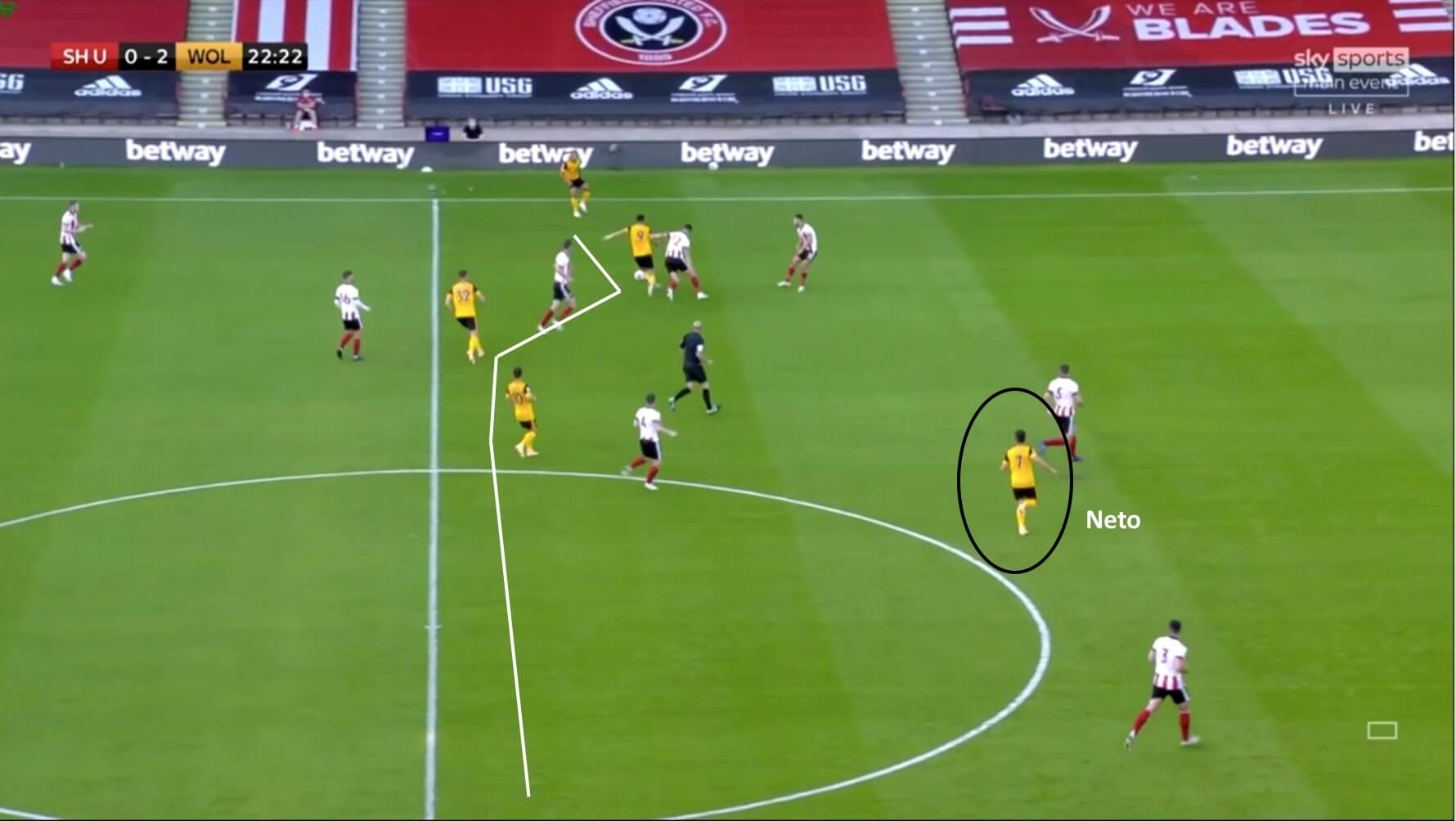
Throughout the first half, the Wolves’ front four popped up at different positions and constantly asked questions. The home side did not have the answers and hence were completely dominated which is evident from the fact that they had merely 42% possession in the first thirty minutes of the game while their first shot on goal came just seven minutes before the break.
Over the past two seasons since Nuno’s side has returned to the Premier League, they have constantly evolved and have showcased a high level of tactical flexibility and versatility. This game showcased that fluidity in attacks can be the next step in tactical evolution for Nuno’s Wolves.
Lacklustre Sheffield United in the first half
Anyone who saw Sheffield United play last season would know that the Blades like to go directly towards the attacking third rather than using a short passing style of buildup play. Once inside the attacking third, they like to create overloads on the flanks by using the overlapping runs of center-backs and finally putting a cross inside the box for the physical attackers. No wonder they were the third-highest team in terms of the actions taken in the attacking third and the fifth-lowest in actions taken in the defensive third during the 19/20 season. Moreover, they attacked the least from the middle amongst all the other teams which indicate their attacking style from wider areas.
For this game, Wilder stuck to the same tactics that brought his team so much success last season. Norwood stayed deep just ahead of the three center-backs during the first phase while the remaining players crowded the opposition half. One of the deeper players, mostly Ramsdale, would look for a long ball towards the 6 foot 2 inches long McBurnie in an attempt to win the second ball in the attacking third and generate an attack from higher up the field.
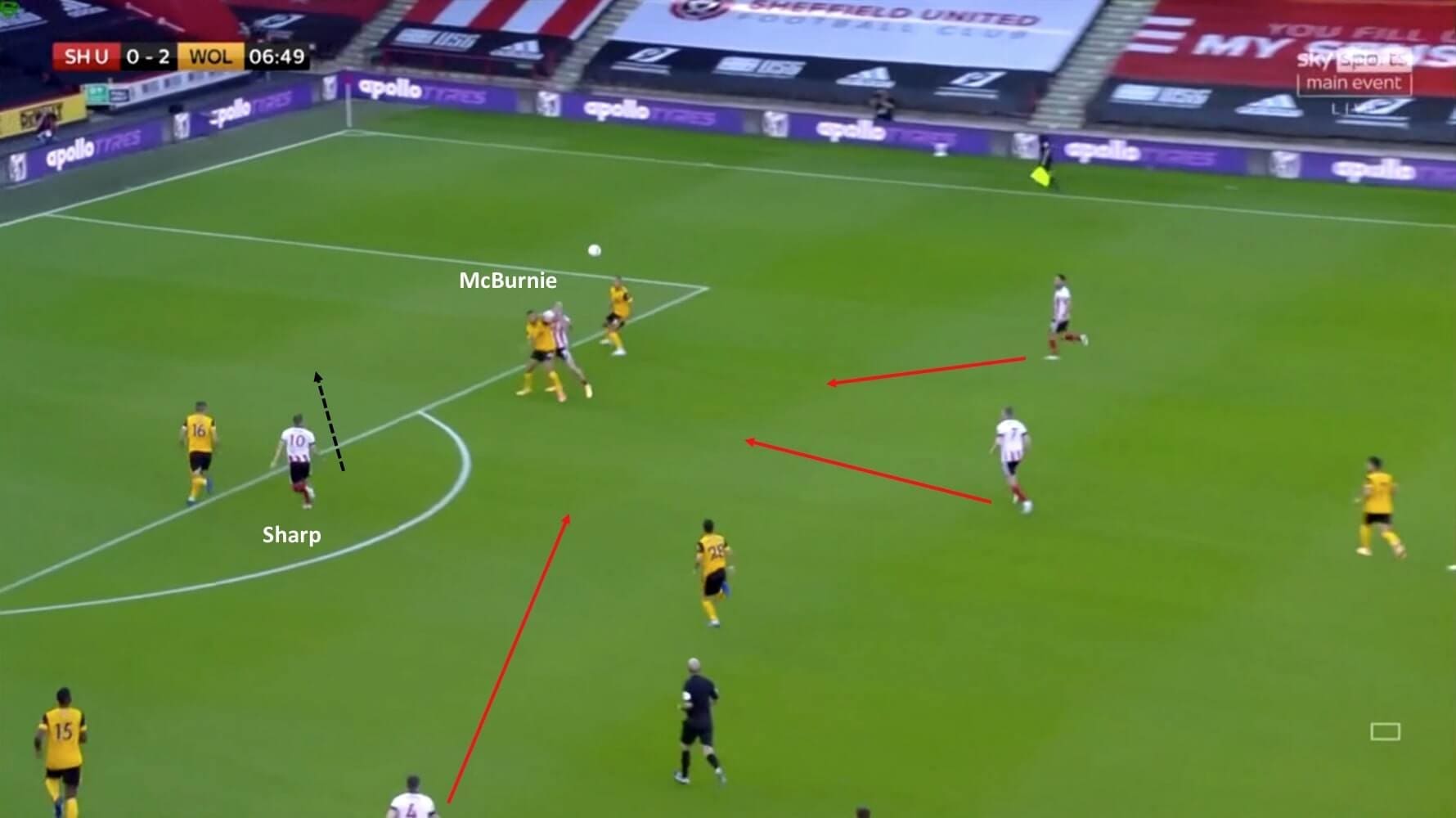
As you can see in the figure, McBurnie is seen to engage in an aerial duel with Saïss. Observe the movements of the three United attackers. While Lundstram and Baldock made a movement towards the ball to win the second-ball, Sharp made a run inside the box in an attempt to isolate himself one versus one against Patrício in case his strike partner could successfully flick the ball under his feet.
In case of an unsuccessful flick, the home side would look to regain the possession as early as possible and circulate it towards the nearest flank, where the near-sided center-back would make a marauding run from the back to overload. This overloading forced Wolves to commit men in the wide areas consequently opening up central space for Norwood to expose, as shown in the following figure. The 29-year old would then look to either switch the play or look to return the ball in the space on the same flank for a wide player to put in a cross inside the box.
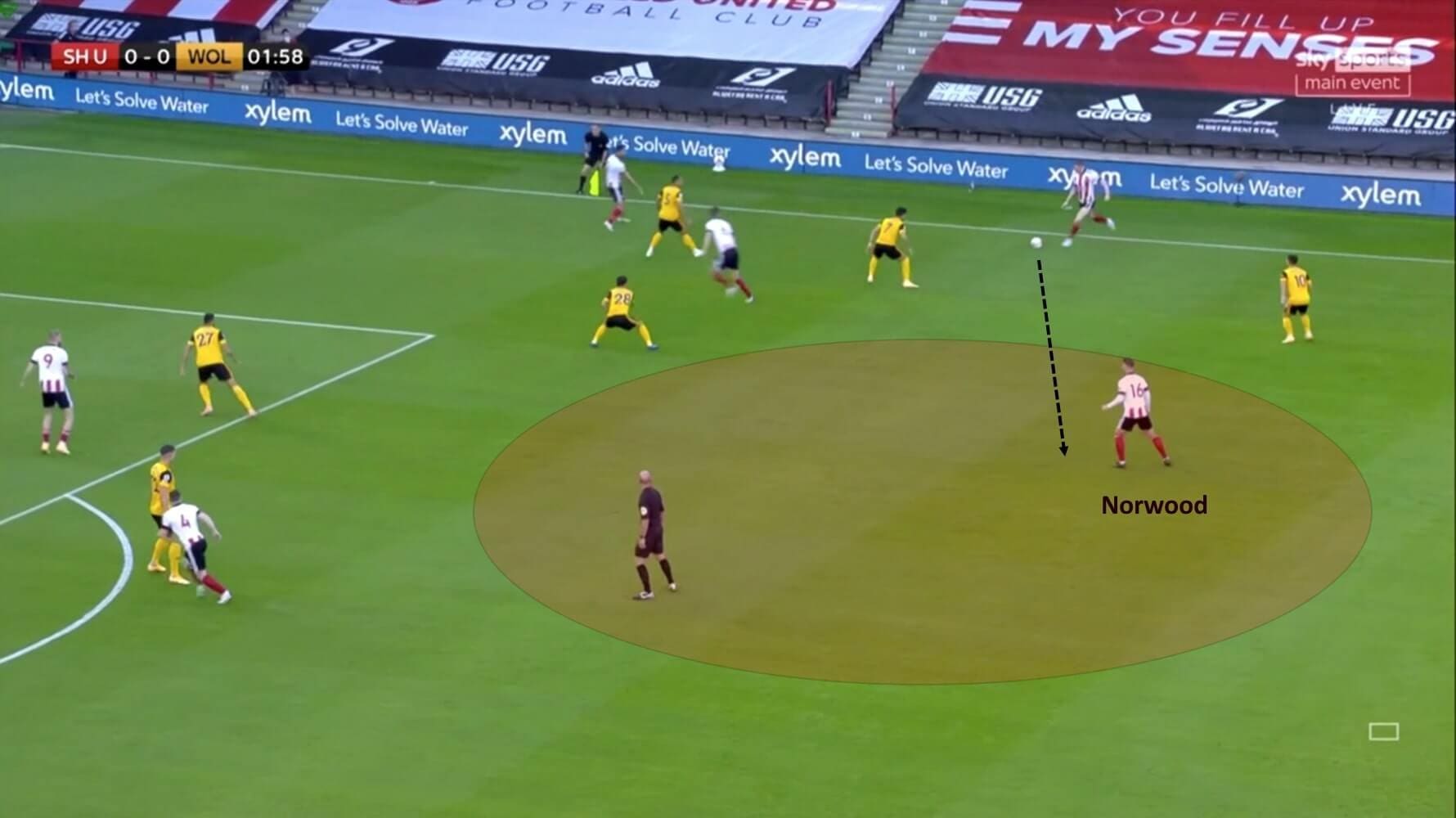
In this tactic, McBurnie needed to win aerial duels to get his team into attacking positions. However, despite indulging in 20 aerial duels, which was the highest in the game, the tall striker was only able to win nine of them. The Wolves defenders, especially Saïss, deserves much credit for keeping the striker quiet in this aspect. Half of McBurnie’s aerial duels were against Saïss which was a part of the tactical plan since Coady and Boly are generally better than the Frenchman in the air. However, the striker could win only 40% of aerial duels against the 30-year old.
Wolves’ low block and rip-roaring counter-attacks
Sheffield United committed a lot of men forward during their build-up play. In response, Wolves had organized themselves in a mid to low 5-3-2 block which was horizontally and vertically compact without possession. The aim was to win the ball back in the own third and generate a quick counter-attack while the home side was short at the back. Hence, Nuno instructed his side to not engage in a high press and rather focus on being compact at the back. Wolves’ pressing intensity (PPDA) value of 45.6 indicates that. It is a high value which shows that the away side created a defensive action after 45.6 passes from Sheffield United. In contrast, the home side’s PPDA metric was 13.2 which was on the much lower side. The following position map of Wolves also is another indication of their low block.
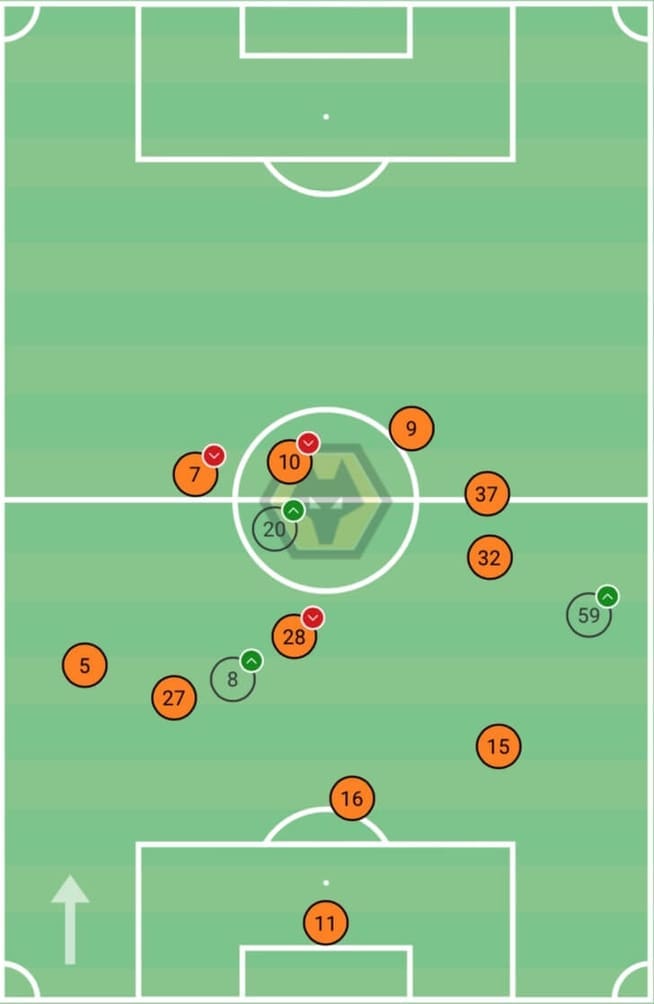
Counter-attacking is one of the biggest strengths of this Wolves side. Since their return to the big league, only four teams have scored more counter-attacking goals than the Molineux-based outfit. The speed and the link-up play between their attackers are the major reasons why they are so good on the break. One of the counter-attacking examples, that lead to the first Wolves’ goal is shown below.
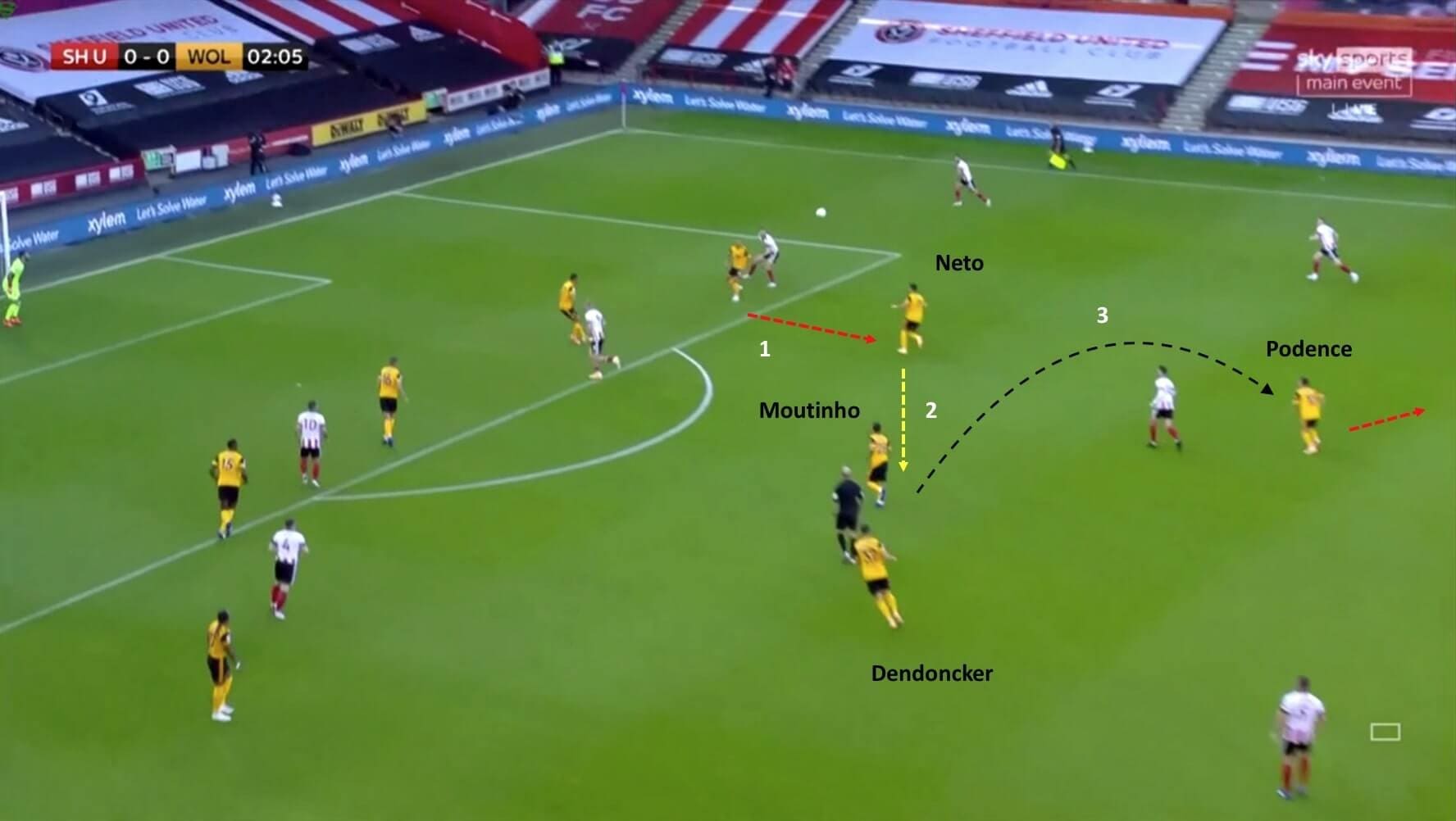
As shown in the figure, eight United players were in the Wolves half which meant only the two center-backs remained at the back for cover. Moreover, the Wolves midfielders are seen to trackback to form a compact 5-3-2 shape to limit the space. Observe the positions of the four Wolves midfielders. If Neto could win the second ball, he could quickly link-up with Moutinho, who would have time and space to orchestrate a counter-attack. This is exactly what happened in this instance. As Moutinho received possession, Dendoncker, Podence, and Jimenez (not in the above image) made a blistering run forward. A simple lob over Norwood put Podence in space and Wolves were near the opposition box in a three versus two in no time, as shown in the following figure.
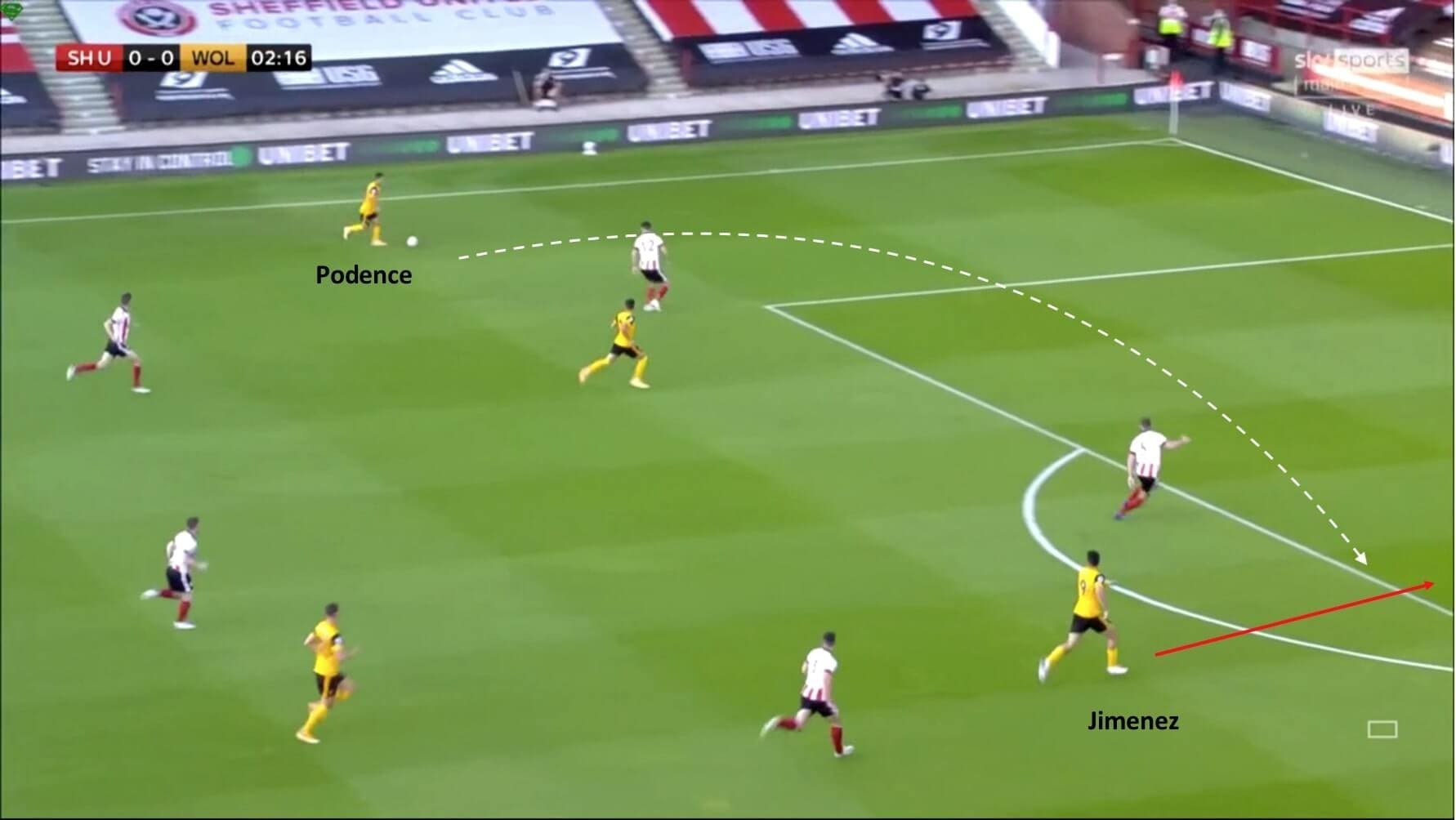
A perfect cross from Podence and a brilliant blind-side run from Jimenez which was capped by a first-time finish allowed the Mexican to take his goal tally to 45 in his 100th appearances for the club.
Apart from the hosts’ vulnerabilities in the buildup play, Wolves were also hurting the home side during their errors in the middle or defensive thirds. The following figure shows an instance when Jimenez pounced from O’Connell’s blind side to intercept a pass from Stevens, who did not recognize the Mexican’s movement. As soon as the striker dribbled past the United defender, Podence and Neto made daunting runs forward to create a similar situation which was seen in the previous example.
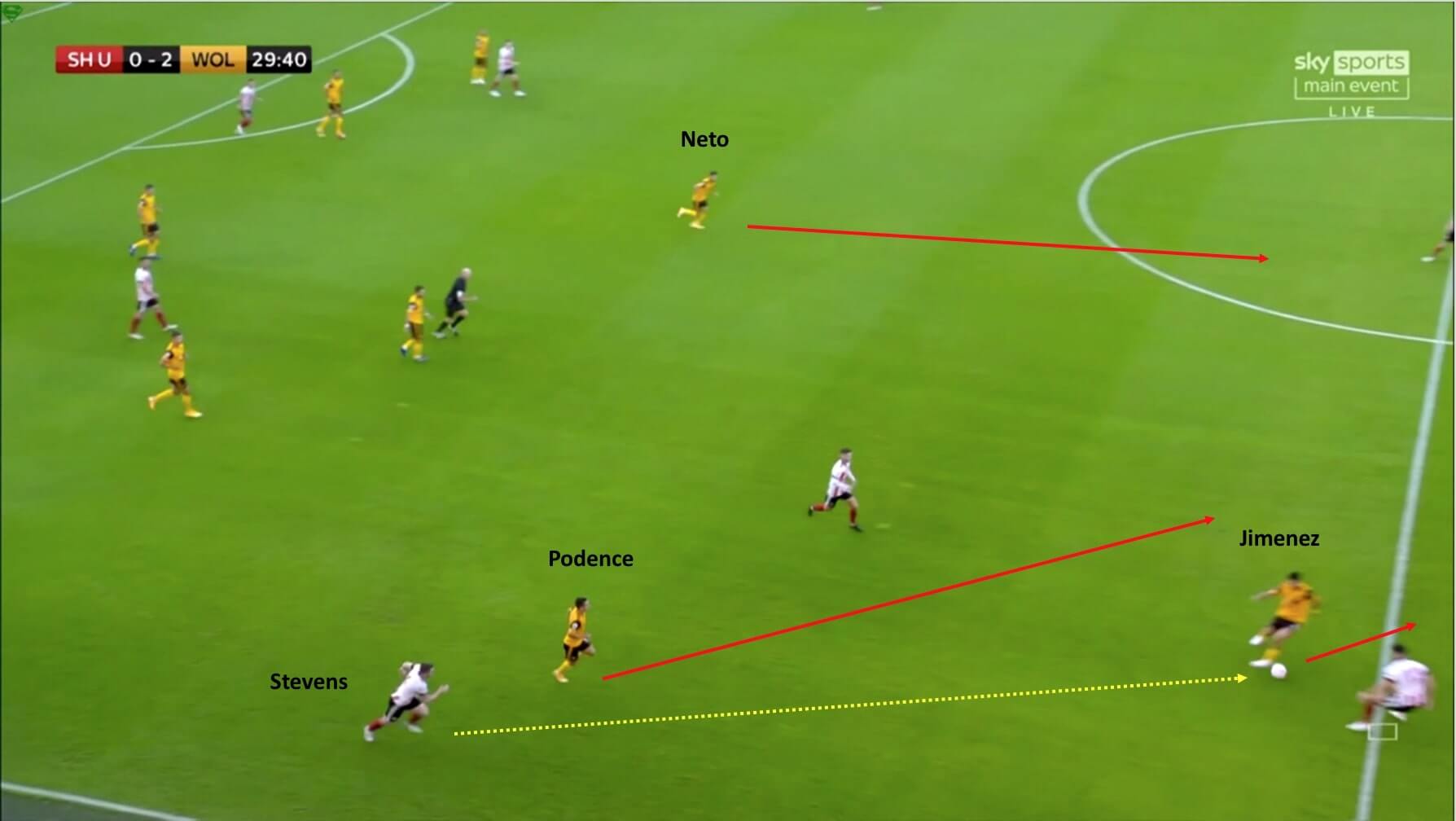
Over 36% of their shots came from a counter-attacking situation in this game which indicates that it was a crucial tactical plan of Nuno which worked.
Final third woes continue to hurt Sheffield United in the second half
Sheffield United came into the second half as a completely different team from the first half. Wilder instructed his side to attack the Wolves’ goal as the Blades started to play with an elevated intensity from the go which shifted the game into the home side’s favor. The famous overlapping center-back tactic, which was not very effective in the first half, started to come to fruition since the restart as the fitness levels between the two sides started to show up.
The Wolves’ intensity, on the other end, dropped naturally due to their lack of match fitness began to show as they pushed their defensive block deeper in the wake of protecting the lead and hitting the Blades only in quick transitions whenever possible. Hence, the home side began to enjoy more possession in the opposition half and created more chances than they did in the first half.
Moreover, spaces began to appear in the Wolves half, which was not seen often in the first half. As shown in the following figure, the midfield line pushed slightly ahead to press the man in possession as the defensive line stayed back to avoid space beyond them. It consequently created space between the lines which McBurnie exposed. The home side came very close to scoring on this occasion as similar situations started occurring often as the game progressed.
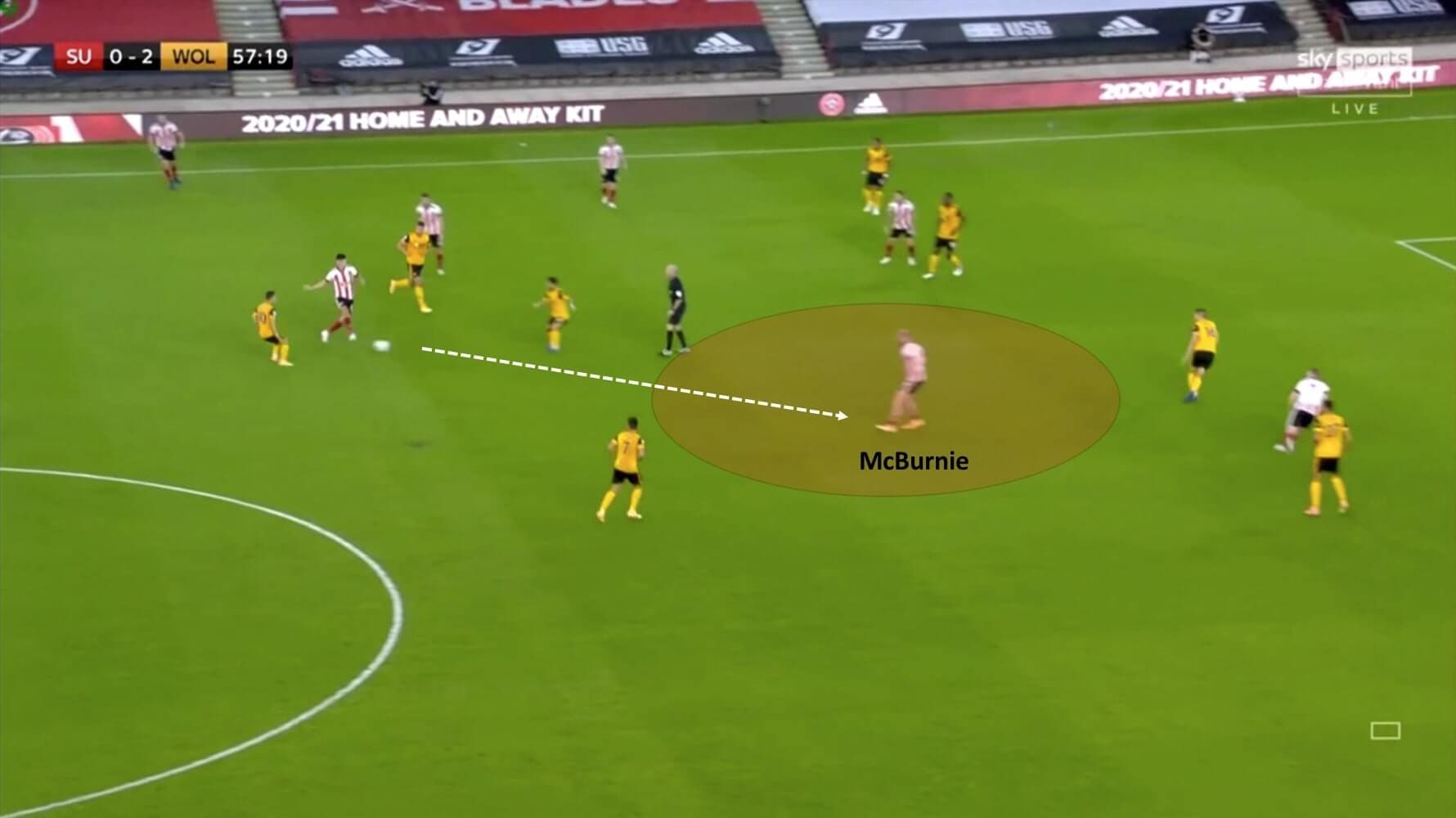
Besides, the home side started to create more opportunities from wide areas as well. While the Wolves were successful in closing down the wide crosses in the first half, the difference in the energy levels between the set of players enabled the home side to play with a higher tempo allowing the wide players to have more time and space to play crosses in the box.
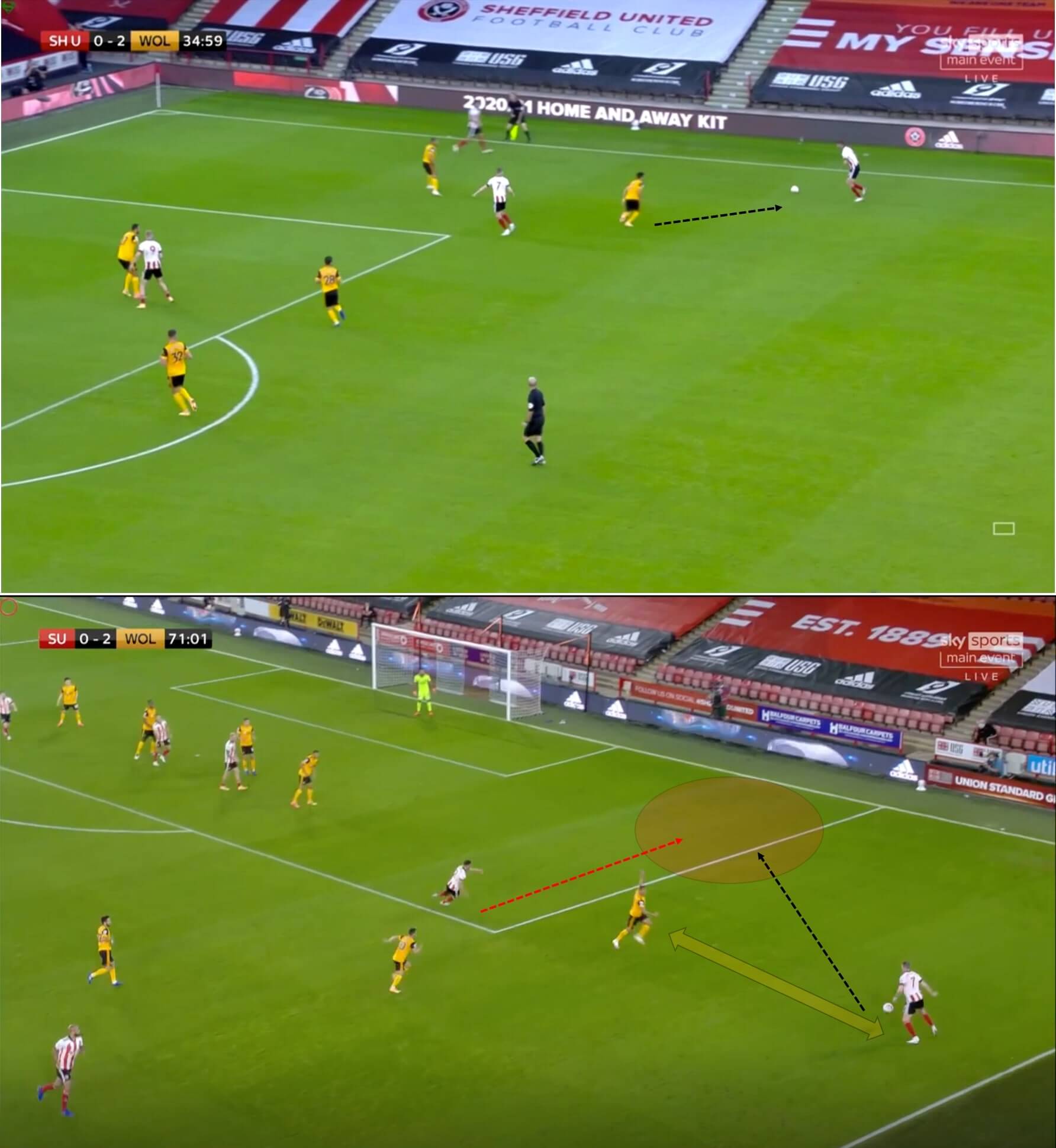
Both the figures show familiar scenes of each half when the Blades are attacked from the flanks. In the first image, Neto was able to charge towards Baldock to intercept the cross in the first half. The second image showed a glimpse of the second half where the fast play from the home side distanced themselves from the Wolves’ defenders and gave them ample space to provide crosses inside the box.
Despite the spaces that the home side was presented all over the opposition half, they were unable to register a goal in the match. Although Wolves deserve credit for resolute defending, Wilder’s men failed to capitalize on the chances due to poor decision making and execution in the final third. The following figure shows an instance of poor decision making.
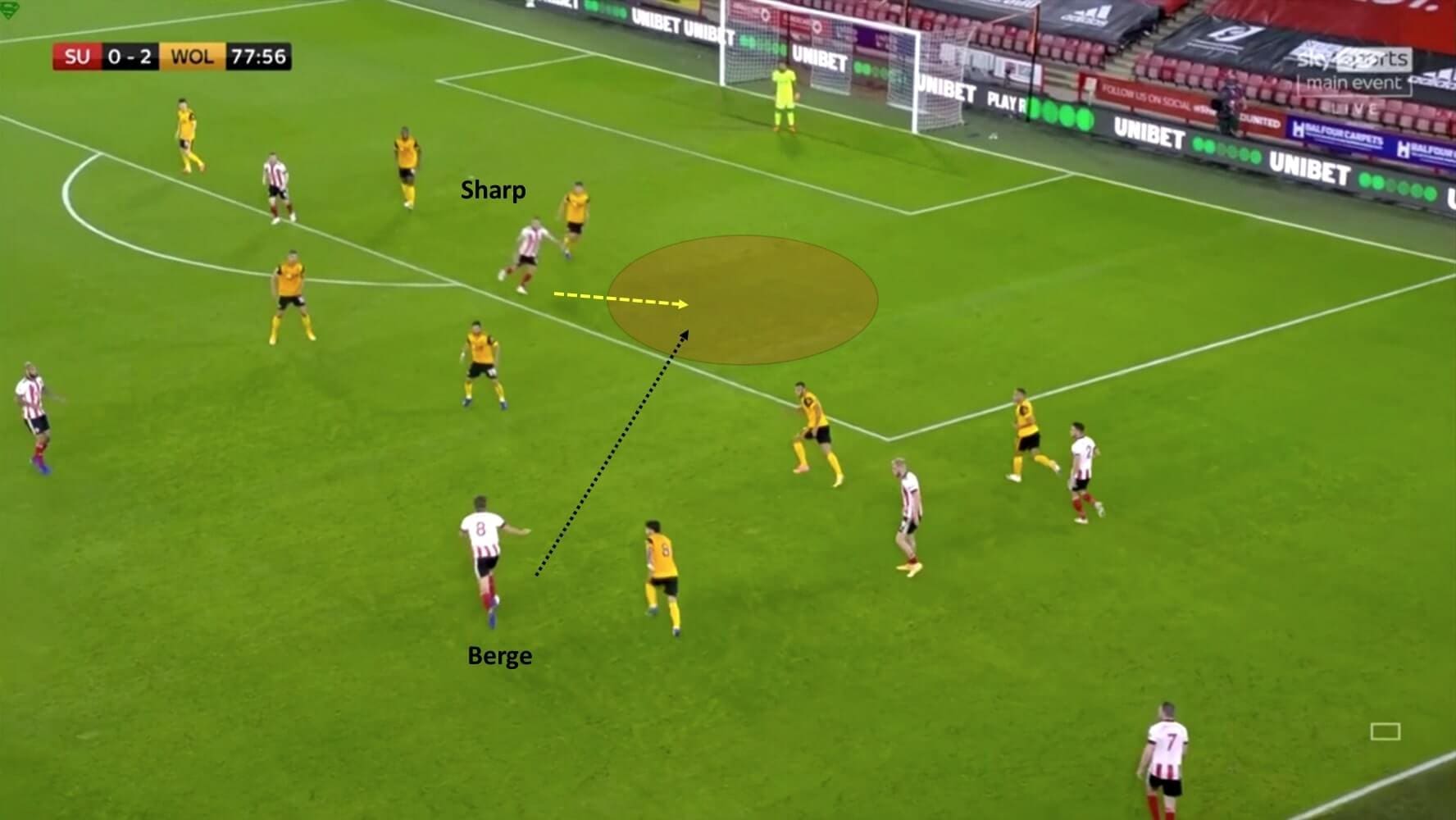
As Sander Berge drove the ball forward in the attacking half, he had an option to pass the ball to Sharp, who was making a run into space within the box. However, Berge chose to continue his run consequently missing out on a potential goal-scoring opportunity.
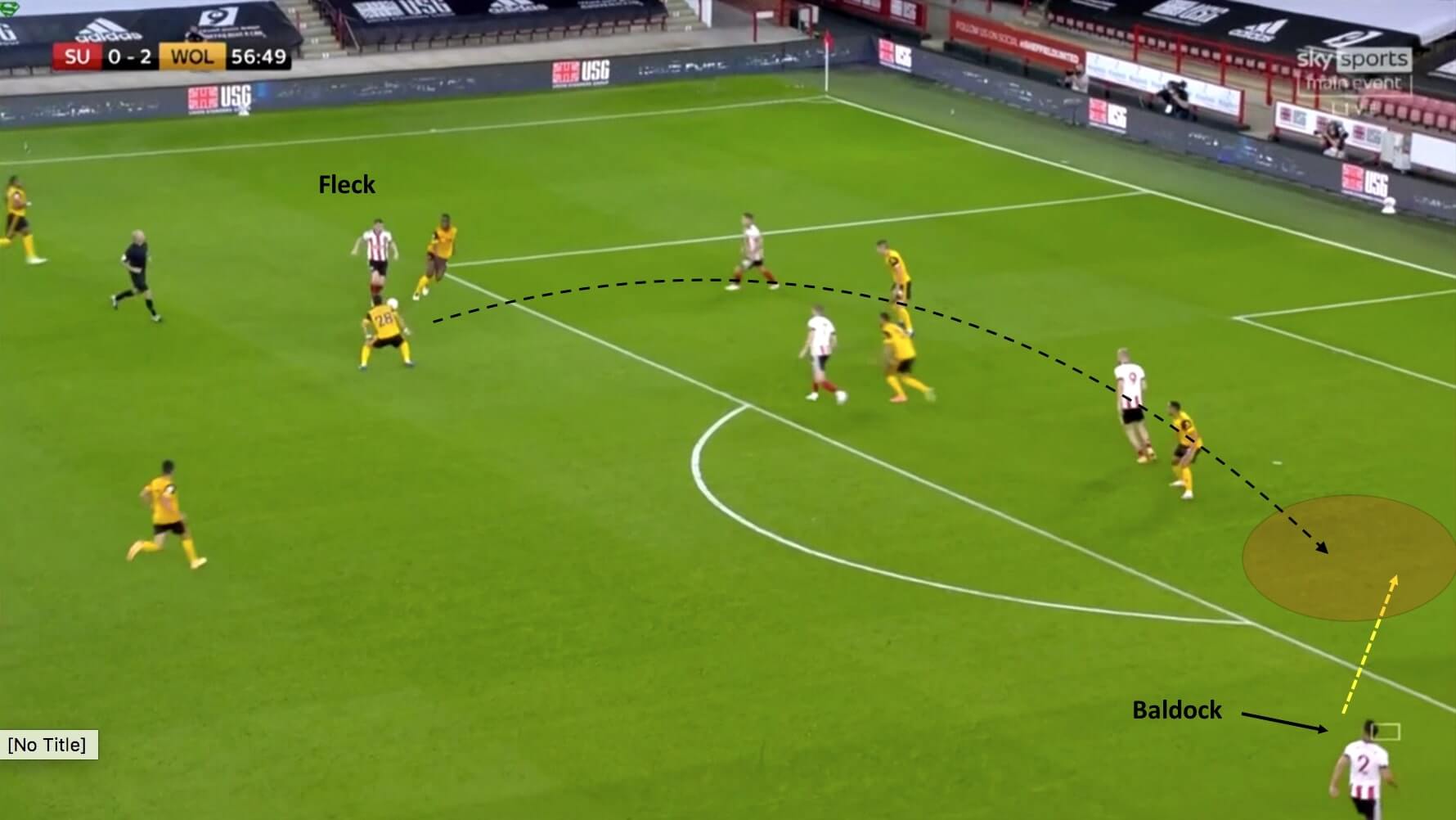
Another instance of poor decision making can be seen in the figure above. Observe the space that Baldock had ahead of him as Fleck looked for options to penetrate the opposition goal. A simple lob towards the wing-back would have created a real opportunity for the Blades. However, the 29-year old chose to drive by himself and eventually lost the ball, in turn throwing away another goal-scoring chance.
United’s issue in the final third was not limited to poor decision making. The home side’s execution inside the box was appalling as well, which is exemplified by the following figure.
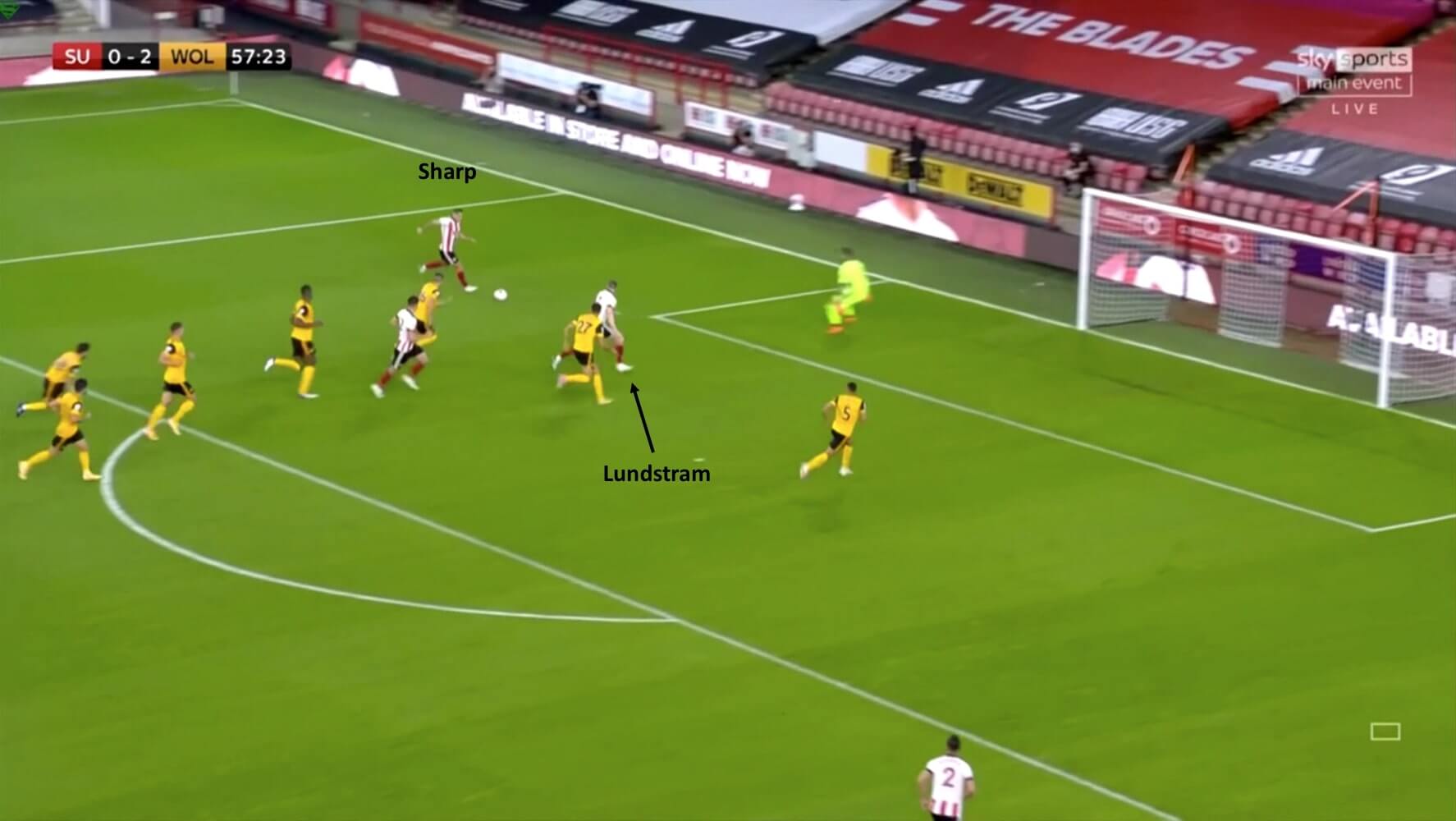
The Blades did extremely well to get into such a wonderful goal scoring position that is shown in the figure. Sharp only required a slightest of touch to provide a simple opportunity for Lundstram to tap-in. However, the striker overhit the ball due to which Lundstram couldn’t reach in time consequently squandering what was the best opportunity for Wilder’s men.
Lack of execution in the final third has been a major issue for Sheffield United which was also evident last season as they were fifth from behind in terms of the goals scored last season despite enjoying the third-highest amount of the possession in the opposition half. Wilder needs to address this concern
Conclusion
Wolves were rightly called as slow starters of a game during the last season since they scored merely 14 out of their 51 goals in the first half. However, a classic counter-attacking goal followed by a set-piece goal just under the first six minutes would have pleased the manager and the fans. More importantly, it was the unwavering defensive display against the fitness odds that was the highlight for the visiting side.
As for Sheffield United, a strong second-half display was not enough to cover the slow start of the game. Although the patterns of play are reminiscent of the last season, the Blades need more creativity in the final third to repeat the success of the last season.
Overall, it was an intriguing game between two teams who had showcased great defensive gameplay in the previous season and exceeded the expectations since coming back to the Premier League. The game lived up to the expectations as it was a match of two different halves. However, Wolves deservedly got the final result in their favor.





Comments